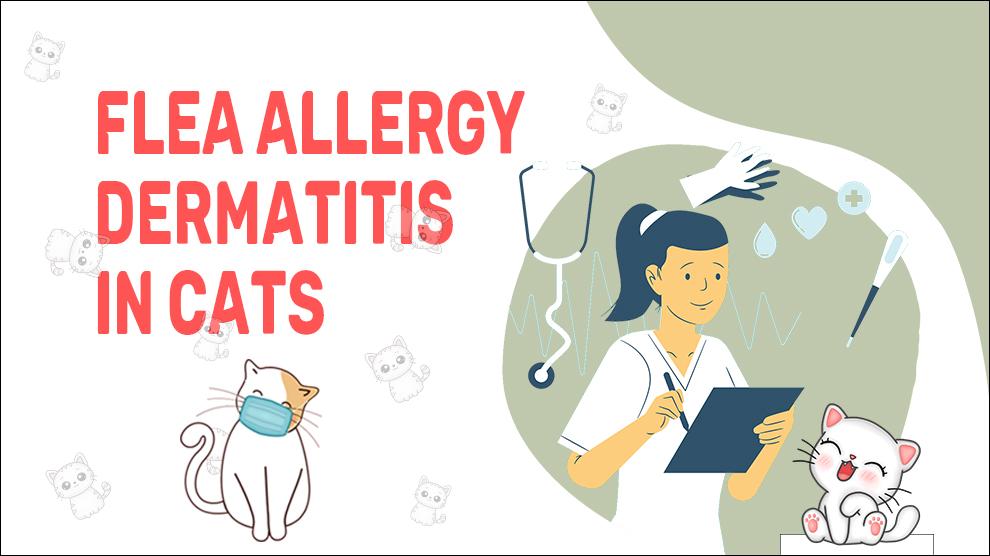What Is Flea Allergy Dermatitis In Cats?
Flea allergy dermatitis (FAD) is a common skin disease in cats caused by an allergic reaction to flea bites.
Fleas are a common parasite that can cause discomfort and irritation in cats. FAD is the most common type of skin allergy in cats and can be extremely uncomfortable for your feline friend.
Fortunately, there are a variety of treatments and preventative measures available to help manage FAD and prevent future outbreaks.
Clinical Signs Of Flea Allergy Dermatitis In Cats
FAD symptoms can vary from mild to severe and can include:
- Excessive scratching or grooming
- Hair loss
- Skin irritation, redness, and swelling
- Scabbing and crusting of the skin
- Hot spots or moist areas on the skin
- Lesions on the head, neck, tail, and groin area
- Skin Bumps
- Pustules
- Itching
- Coughing
- Sneezing
- Wheezing
- Nasal Discharge
- Mucus Discharge In Eyes
- Vomiting
- Flatulence
- Diarrhea
In severe cases, FAD can also cause anemia and weight loss.
Treatment Options For Flea Allergy Dermatitis In Cats
Treatment options for FAD typically involve managing the symptoms and eliminating fleas from the cat and its environment.
Some of the most common treatment options include:
- Flea control measures: Preventing fleas from biting the cat is the best way to manage FAD. This can be achieved through the use of flea prevention medications, such as topical or oral treatments.
- Medication: Anti-inflammatory medication or steroid injections can help manage itching and inflammation caused by FAD.
- Medicated shampoos: Medicated shampoos containing oatmeal or other soothing ingredients can help relieve symptoms of FAD and soothe irritated skin.
- Antibiotics: In severe cases, antibiotics may be prescribed to treat any secondary infections caused by excessive scratching or licking.
- Allergy shots: Immunotherapy, or allergy shots, can be used to desensitize cats to flea saliva and other allergens over time.
Home Remedies For Flea Allergy Dermatitis In Cats
There are several home remedies that may provide relief for cats with flea allergy dermatitis, including:
- Frequent bathing: Regular baths with mild, hypoallergenic shampoo can help remove fleas and soothe irritated skin.
- Apple cider vinegar: Diluted apple cider vinegar can be used as a natural flea repellent and may help relieve itching.
- Coconut oil: Applying coconut oil to affected areas can moisturize the skin and reduce inflammation.
- Vitamin E: Topical application of vitamin E oil can help soothe and heal irritated skin.
It is important to note that while home remedies may provide some relief, they are not a substitute for veterinary care.
It is always recommended to consult with a veterinarian before attempting any home remedies.
How To Prevent Flea Allergy Dermatitis In Cats?
Prevention is key when it comes to managing FAD.
Some preventative measures include:
- Regular grooming: Brushing and combing your cat's coat regularly can help remove fleas and their eggs from the fur.
- Flea prevention medication: Using flea prevention medication, such as topical or oral treatments, can help prevent fleas from biting your cat.
- Regular cleaning: Regularly cleaning your cat's bedding, toys, and litter box can help prevent flea infestations in your home.
- Environmental control: Vacuuming your home regularly and treating your home and yard with flea control products can help prevent flea infestations.
Affected Cat Breeds Of Flea Allergy Dermatitis
Flea allergy dermatitis can affect any breed of cat, but some breeds may be more susceptible due to their sensitive skin.
These breeds include the Himalayans, Siamese, Devon Rex, and Sphinx.
Causes For Flea Allergy Dermatitis In Cats
Causes:
Flea allergy dermatitis is caused by an allergic reaction to flea saliva.
When fleas bite a cat, they inject saliva into the skin which contains proteins that can cause an allergic reaction in some cats.
This allergic reaction causes intense itching and discomfort for the cat, leading to excessive scratching and grooming. FAD can occur in cats of any age and breed and is more common in cats that spend time outdoors.
When To See A Vet For Flea Allergy Dermatitis In Cats?
If you suspect your cat has FAD, it's important to schedule an appointment with a veterinarian.
A veterinarian can diagnose FAD through a skin test or physical examination and can recommend the best course of treatment for your cat's individual needs.
If left untreated, FAD can lead to secondary infections and more serious health problems.
Food Suggestions For Flea Allergy Dermatitis In Cats
There are certain foods that may help support a cat's skin and coat health, which may in turn help alleviate the symptoms of flea allergy dermatitis.
Some of these foods include:
- Salmon: Rich in omega-3 fatty acids, salmon can help reduce inflammation and promote healthy skin and coat.
- Turkey: A lean source of protein, turkey contains zinc, which is important for skin health.
- Sweet potatoes: A good source of beta-carotene, sweet potatoes can help support healthy skin.
- Blueberries: Rich in antioxidants, blueberries can help reduce inflammation and protect against oxidative stress, which can be a factor in skin allergies.
- Spinach: High in iron and other vitamins and minerals, spinach can help support overall health and may also benefit skin and coat health.
It's important to note that while incorporating these foods into a cat's diet may help support skin health, it's not a replacement for proper flea prevention and treatment.
Consult with a veterinarian for recommendations on a well-balanced diet that meets your cat's individual nutritional needs.
Conclusion
Flea allergy dermatitis is a common condition in cats that can cause severe itching and discomfort.
It is caused by an allergic reaction to flea saliva and can lead to secondary infections and other health issues if left untreated.
Prevention is key in managing flea allergy dermatitis, including regular flea control measures and keeping cats indoors.
If a cat is suspected to have flea allergy dermatitis, it is important to seek veterinary care for proper diagnosis and treatment.











